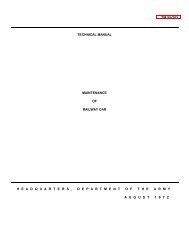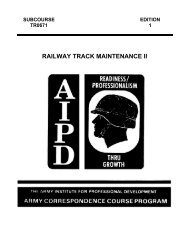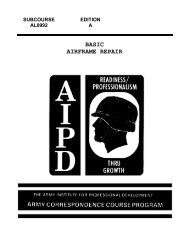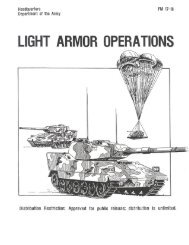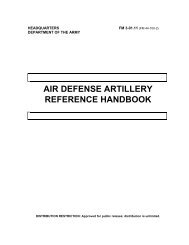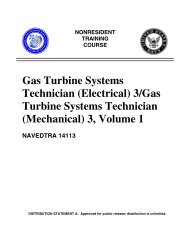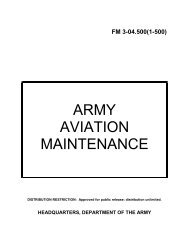fm 44-100 us army air and missile defense operations
fm 44-100 us army air and missile defense operations
fm 44-100 us army air and missile defense operations
Create successful ePaper yourself
Turn your PDF publications into a flip-book with our unique Google optimized e-Paper software.
FM<strong>44</strong>-<strong>100</strong><br />
zones are examples of supplemental fire control measures. Joint Pub 3-52,<br />
FM <strong>100</strong>-103, <strong>and</strong> FM <strong>100</strong>-103-1 provide further details.<br />
POSITIVE CONTROL<br />
5-79. Positive control relies upon near-real-time data from sensors, IFF,<br />
computers, digital data links, <strong>and</strong> communications equipment to provide<br />
<strong>air</strong>space <strong>and</strong> <strong>air</strong> <strong>defense</strong> control. Positive control is desirable but not always<br />
possible due to battlefield conditions <strong>and</strong> inherent system vulnerabilities.<br />
Facilities for positive control are subject to direct attack, sabotage, or<br />
jamming. Line-of-sight requirements <strong>and</strong> limited communications can also<br />
restrict the availability of data from facilities that are operational.<br />
PROCEDURAL CONTROL<br />
5-80. Procedural control overcomes positive control <strong>and</strong> identification<br />
shortcomings. Procedural control relies upon techniques such as segmenting<br />
<strong>air</strong>space by volume, time, <strong>and</strong> <strong>us</strong>ing weapon control stat<strong>us</strong>es. Procedural<br />
techniques are <strong>us</strong>ually more restrictive than positive techniques but are less<br />
vulnerable to degradation from electronic or physical attack. Procedural<br />
control enhances the continuity of <strong>operations</strong> under the adverse conditions<br />
expected on the battlefield. For example, it provides an immediate backup<br />
system should degradation of positive control occur. Additionally, procedural<br />
techniques provide a management means for <strong>air</strong> <strong>defense</strong> systems that do not<br />
have near-real-time data transmission capabilities.<br />
MIX OF POSITIVE AND PROCEDURAL CONTROL<br />
5-81. An optimum method of controlling <strong>air</strong> <strong>defense</strong> <strong>operations</strong> is a mix of<br />
positive <strong>and</strong> procedural techniques. Comm<strong>and</strong>ers charged with <strong>air</strong> battle<br />
management consider the factors of METT-TC in their analysis. They<br />
specifically foc<strong>us</strong> on mission, AO, <strong>and</strong> the threat expected.<br />
5-82. For positive management, comm<strong>and</strong>ers consider the numbers <strong>and</strong> types<br />
of electronic means available. This will vary according to the depth of the<br />
battlefield. As <strong>operations</strong> move farther forward, available means for positive<br />
control decrease, necessitating additional procedural management.<br />
5-83. Air traffic behind the division generally moves in ways that are<br />
normally well suited for positive control. Air <strong>defense</strong> is <strong>us</strong>ually in a critical or<br />
static asset <strong>defense</strong> role in this area. In this area of the battlefield, positive<br />
control is easier to effect <strong>and</strong> is <strong>us</strong>ually the preferred method.<br />
5-84. Forward of the corps, the generally high volume of <strong>air</strong>craft <strong>and</strong> friendly<br />
<strong>missile</strong>s can make positive control extremely difficult. Flexible <strong>and</strong> varying<br />
missions can also necessitate more reliance on procedural control.<br />
5-85. The nature of the theater may also dictate what type of control is <strong>us</strong>ed.<br />
Mature theaters have elaborate <strong>and</strong> tested electronic management facilities<br />
in place. Contingency theaters may have no such systems in place <strong>and</strong> will<br />
rely more heavily on procedural control. As the lodgment area exp<strong>and</strong>s <strong>and</strong><br />
additional assets arrive in the theater, a transition to positive control may<br />
take place.<br />
5-19




